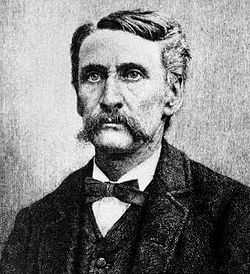Sherburne Wesley Burnham

Sherburne Wesley Burnham (December 12, 1838 – March 11, 1921) was an American astronomer. His parents were Roswell O. and Marinda (née Foote) Burnham.[1]
Biography
Burnham worked at Yerkes Observatory. All his working life, he served during the day as a court reporter and was an amateur astronomer, except for four years as a full-time astronomer at Lick Observatory.
He served as a military stenographer in the Union Army in the Civil War. In 1873 – 1874, he produced a catalog of double stars. He became a fellow of the Royal Astronomical Society. He continued to identify double stars and later published the General Catalogue of 1290 Double Stars. In 1906, he published the Burnham Double Star Catalogue, containing 13,665 pairs of double stars.
For more than fifty years he spent all his free time observing the heavens, principally concerning himself with binary stars. Friedrich Georg Wilhelm von Struve and Otto Wilhelm von Struve had catalogued a good number of binary stars working at the Observatories of Dorpat and Pulkovo and using 23- and 38-cm telescopes. During the 1840s it was believed that essentially all the binary stars visible to the instruments of the day had been discovered. Burnham, with his 15-cm instrument, found 451 new ones from 1872 to 1877. The quality of his work opened the doors of observatories for him and he had access to more powerful instruments at Lick, Yerkes and other observatories. He is credited with having discovered 1340 binary stars.
Burnham discovered the first example of, what would be called a-half century later, a Herbig–Haro object: Burnham's Nebula (now labeled as HH255).
He received the Gold Medal of the Royal Astronomical Society in 1894. The French Academy of Sciences awarded him the Lalande Prize for 1904.[2]
The lunar crater Burnham and asteroid 834 Burnhamia were named in his honour.
References
- ↑ Hockey, Thomas (2009). The Biographical Encyclopedia of Astronomers. Springer Publishing. ISBN 978-0-387-31022-0. Retrieved August 22, 2012.
- ↑ "Séance du 19 décembre". Le Moniteur scientifique du Doctor Quesneville: 153–154. February 1905.
External links
- Note on Hind's Variable Nebula in Taurus, Monthly Notices of the Royal Astronomical Society, Vol. 51, p. 94 (1890)
- Double star observations made with the thirty-six-inch and twelve-inch refractors of the Lick observatory, from August, 1888, to June, 1892, Publications of the Lick Observatory, Vol. 2, p. 175 (1894)
|